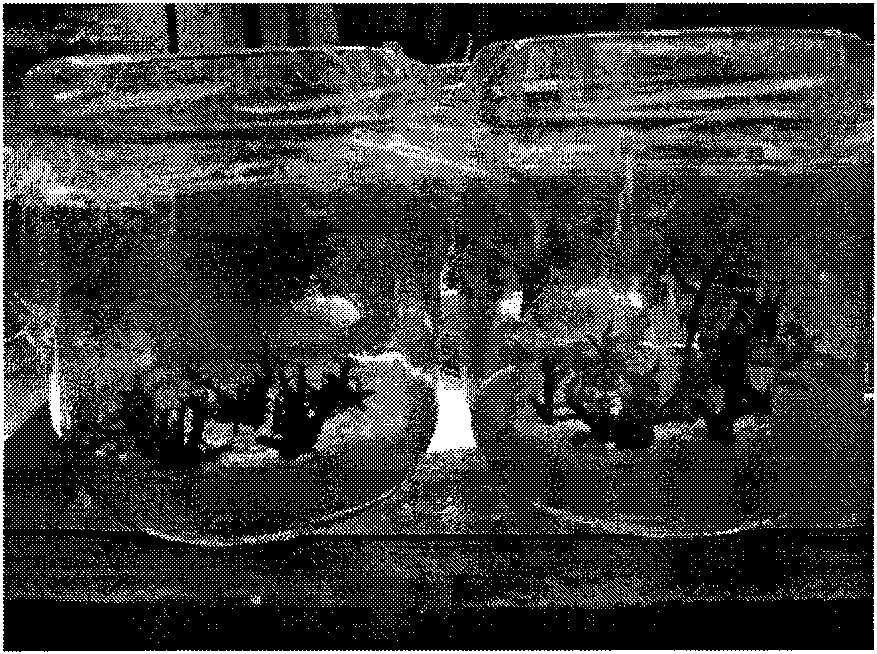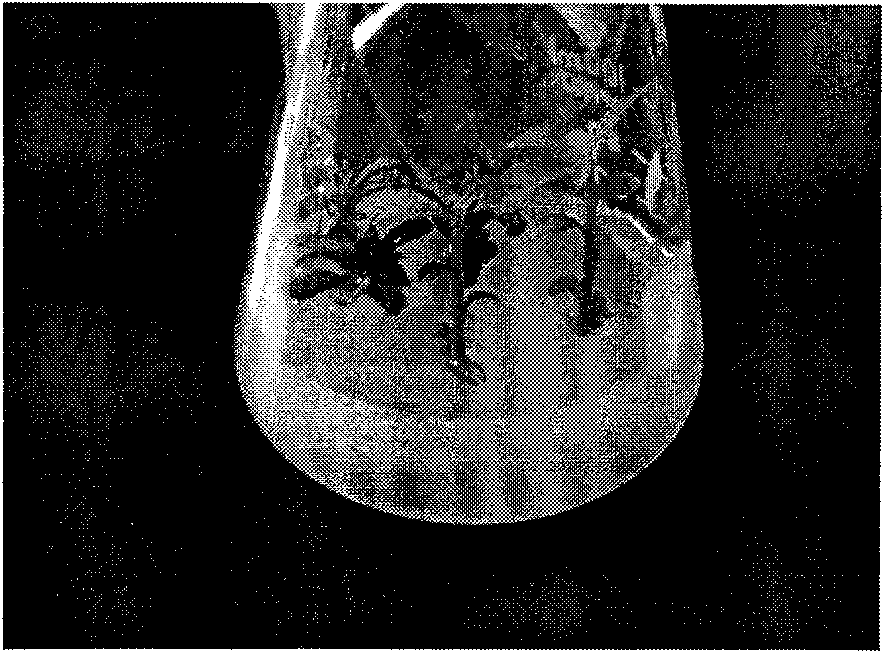Efficient rooting method for oil tea clone tissue culture seedlings
A technology for tissue culture seedlings and clones, which is applied to the field of rooting of tissue culture seedlings of Camellia oleifera clones, and can solve the problems of difficult rooting of tissue culture seedlings, difficulty in transplanting and survival, etc.
- Summary
- Abstract
- Description
- Claims
- Application Information
AI Technical Summary
Problems solved by technology
Method used
Image
Examples
Embodiment 1
[0023] Cut the young shoots of the year from the robust plants of Camellia oleifera, and take the top 4--6 cm for disinfection; transfer the aseptic seedlings obtained in the first generation to WPM+BA3mg / L+IBA0.5mg / L+ZT0.05mg / L Subculture, the multiplication period is 40 days, and the multiplication coefficient reaches 4.2; the aseptic seedlings obtained in the multiplication process are strengthened by WPM+IBA1.0mg / L+biotin 0.5mg / L, and the tissue-cultured seedlings grow to 2- Take it out from the culture bottle at -4 cm, soak the base of the tissue culture seedling in 1000ppm IBA solution for 10 seconds, then inoculate it on the medium of 1 / 4MS+AC200, and the rooting rate reaches 89% after 30 days. After rooting, the tissue-cultured seedlings were moved to a nutrient cup, the substrate was peat soil:perlite=3:1, and the transplanting survival rate reached 93%.
[0024] The specific operation is as follows:
[0025] (1) Transfer the obtained sterile seedlings to the subcult...
Embodiment 2
[0029] Cut the young shoots of the year from the robust plants of Camellia oleifera, and take the top 4--6cm for disinfection; transfer the sterile seedlings obtained from the first generation to WPM+BA5mg / L+IBA2mg / L+ZT2mg / L for subculture, and the multiplication cycle After 30 days, the multiplication coefficient reached 9.1; the aseptic seedlings obtained in the multiplication process were strengthened by WPM+IBA0.1mg / L+biotin 2mg / L, and when the tissue cultured seedlings grew to 2--4 cm in 25 days, they were cultivated Take it out from the bottle, soak the base of the tissue culture seedling in 3000ppm IBA solution for 5 seconds, then inoculate it on the medium of MS+AC600, and the rooting rate reaches 91% after 25 days. After rooting, the tissue-cultured seedlings were moved to a nutrient cup, the substrate was peat soil:perlite=2:1, and the transplanting survival rate reached 91%.
[0030] See embodiment 1 for specific operations.
Embodiment 3
[0032] Cut the young shoots of the current year from the robust plants of Camellia oleifera, and take the top 4--6cm for disinfection; transfer the sterile seedlings obtained in the first generation to WPM+BA5mg / L+IBA0.1mg / L+ZT1mg / L for subculture, The multiplication cycle is 35 days, and the multiplication coefficient reaches 7.1; the sterile seedlings obtained during the multiplication process are strengthened by WPM+IBA2mg / L+biotin 3mg / L, and the tissue cultured seedlings grow to 2--3 cm in 25 days. Take it out from the bottle, soak the base of the tissue culture seedling in 4000ppm IBA solution for 5 seconds, then inoculate it on the medium of 1 / 2MS+AC400, and the rooting rate reaches 85% after 30 days. After rooting, the tissue-cultured seedlings were moved to a nutrient cup, the substrate was peat soil:perlite=1:1, and the transplanting survival rate reached 89%.
[0033] See embodiment 1 for specific operations.
PUM
 Login to View More
Login to View More Abstract
Description
Claims
Application Information
 Login to View More
Login to View More - R&D
- Intellectual Property
- Life Sciences
- Materials
- Tech Scout
- Unparalleled Data Quality
- Higher Quality Content
- 60% Fewer Hallucinations
Browse by: Latest US Patents, China's latest patents, Technical Efficacy Thesaurus, Application Domain, Technology Topic, Popular Technical Reports.
© 2025 PatSnap. All rights reserved.Legal|Privacy policy|Modern Slavery Act Transparency Statement|Sitemap|About US| Contact US: help@patsnap.com



